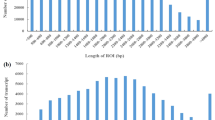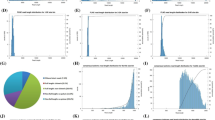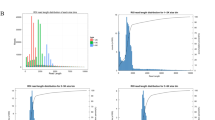Abstract
Key message
Combination analysis of single-molecule long-read and Illumina sequencing provide full-length transcriptome information and shed new light on the anthocyanin accumulation mechanism of Pennisetum setaceum cv. ‘Rubrum’.
Abstract
Pennisetum setaceum cv. ‘Rubrum’ is an ornamental grass with purple leaves widely used in landscaping. However, the current next-generation sequencing (NGS) transcriptome information of this species is not satisfactory due to the difficulties in obtaining full-length transcripts. Furthermore, the molecular mechanisms of anthocyanin accumulation in P. setaceum have not been thoroughly studied. In this study, we used PacBio full-length transcriptome sequencing (SMRT) combined with NGS technology to build and improve the transcriptomic datasets and reveal the molecular mechanism of anthocyanin accumulation in P. setaceum cv. ‘Rubrum’. Therefore, 280,413 full-length non-chimeric reads sequences were obtained using the SMRT technology. We obtained 97,450 high-quality non-redundant transcripts and identified 5352 alternative splicing events. In addition, 93,066 open reading frames (ORFs), including 57,457 full ORFs and 2910 long non-coding RNA (lncRNAs) were screened out. Furthermore, 10,795 differentially expressed genes were identified using NGS. We also explored key genes, synthesis pathways, and detected lncRNA involved in anthocyanin accumulation, providing new insights into anthocyanin accumulation in P. setaceum cv. ‘Rubrum’. To our best knowledge, we provided the full-length transcriptome information of P. setaceum cv. ‘Rubrum’ for the first time. The results of this study will provide baseline information for gene function studies and pave the way for future P. setaceum cv. ‘Rubrum’ breeding projects.











Similar content being viewed by others
Data availability
The PacBio and Illumina sequencing data used in this study has been submitted to the BioProject database of National Center for Biotechnology Information (PRJNA741859, https://dataview.ncbi.nlm.nih.gov/object/PRJNA744323?reviewer=ivb94nq6f5qteehsn84kakpmo; PRJNA744323 https://dataview.ncbi.nlm.nih.gov/object/PRJNA741859?reviewer=14da3so0n8gbcig59abfjr5fh7).
Abbreviations
- ANS:
-
Anthocyanidin synthase
- AS:
-
Alternative splicing events
- CCS:
-
Circular consensus
- CDS:
-
Putative coding sequences
- CHI:
-
Chalcone isomerase
- CHS:
-
Chalcone synthase
- COG:
-
Cluster of orthologous groups
- DEGs:
-
Differentially expressed genes
- DETs:
-
Differentially expressed transcripts
- DFR:
-
Dihydroflavonol 4-reductase
- F3H :
-
Flavonoid 3-hydroxylase
- F3'H:
-
Flavonoid 3′-hydroxylase
- FLNC:
-
Full-length non-chimeric reads
- FPKM:
-
Fragments per kilobase of transcript per million fragments
- GO:
-
Gene ontology
- HQ:
-
High quality isoforms
- ICE:
-
Iterative isoform-clustering program
- KEGG:
-
Kyoto encyclopedia of genes and genomes
- LncRNA:
-
Long non-coding RNA
- LQ:
-
Low quality isoforms
- NFL:
-
Non-full-length
- NGS:
-
Next generation sequencing
- NR:
-
NCBI non-redundant protein databases
- ORF:
-
Open reading frame
- ROI:
-
Reads of insert
- SMRT:
-
PacBio single-molecule long-read sequencing technology
- TFs:
-
Transcription factors
- UFGT:
-
Anthocyanidin 3-glycosyltransferase
References
An J, Xu R, Liu X, Zhang J, Wang X, You C, Hao Y (2021) Jasmonate induces biosynthesis of anthocyanin and proanthocyanidin in apple by mediating the JAZ1-TRB1-MYB9 complex. Plant J 106(5):1414–1430
Beckwith AG, Zhang Y, Seeram NP, Cameron CA, Nair MG (2004) Relationship of light quantity and anthocyanin production in Pennisetum setaceum Cvs. rubrum and red riding hood. J Agric Food Chem 52(3):456–461
Bella S, D’Urso V (2012) First record in the Mediterranean basin of the alien leafhopper Balclutha brevis living on invasive Pennisetum setaceum. Bull Insectol 65(2):195–198
Bing Z, Liu J, Wang X, Wei Z (2018) Full-length RNA sequencing reveals unique transcriptome composition in bermudagrass. Plant Physiol Biochem 132:95–103
Chao Y, Yuan J, Li S, Jia S, Han L, Xu L (2018) Analysis of transcripts and splice isoforms in red clover (Trifolium pratense L.) by single-molecule long-read sequencing. BMC Plant Biol 18(1):300
Chao Y, Yuan J, Guo T, Xu L, Mu Z, Han L (2019) Analysis of transcripts and splice isoforms in Medicago sativa L. by single-molecule long-read sequencing. Plant Mol Biol 99(3):219–235
Chen X, Xia L, Zhu S, Tang S, Mei S, Chen J, Shan L, Liu M, Gu Y, Dai Q (2018) Transcriptome-referenced association study of clove shape traits in garlic. DNA Res 25(6):587–596
Chen D, Liu Y, Yin S, Qiu J, Jin Q, King GJ, Wang J, Ge X, Li Z (2020) Alternatively spliced BnaPAP2.A7 isoforms play opposing roles in anthocyanin biosynthesis of Brassica napus L. Front Plant Sci 11:983
Dewey CN, Bo L (2011) RSEM: accurate transcript quantification from RNA-seq data with or without a reference genome. BMC Bioinform 12(1):323–323
Fleming MB, Patterson EL, Reeves PA, Richards CM, Walters C (2018) Exploring the fate of mRNA in aging seeds: protection, destruction, or slow decay? J Exp Bot 69(18):4309–4321
Fossen T, Andersen ØM (1998) Cyanidin 3-O-(6″-Succinyl-β-glucopyranoside) and other anthocyanins from phragmites australis. J Agric Food Chem 49(4):1065–1068
Fossen T, Slimestad R, Andersen OM (2001) Anthocyanins from maize (Zea mays) and reed canarygrass (Phalaris arundinacea). J Agric Food Chem 49(5):2318–2321
Frank M, Harald K, Pawel B, Bernd W (2005) The Arabidopsis transcription factor MYB12 is a flavonol-specific regulator of phenylpropanoid biosynthesis. Plant Physiol 138(2):1083–1096
Godzik LA (2006) Cd-hit: a fast program for clustering and comparing large sets of protein or nucleotide sequences. Bioinformatics 22(13):1658–1659
Goergen E, Daehler CC (2002) Factors affecting seedling recruitment in an invasive grass (Pennisetum setaceum) and a nativegrass (Heteropogon contortus) in the Hawaiian Islands. Plant Ecol 161(2):147–156
Gould KS, Markham KR, Smith RH, Goris JJ (2000) Functional role of anthocyanins in the leaves of Quintinia serrata A. Cunn. J Exp Bot 51(347):1107–1115
Harborne JB, Self R (1987) Malonated cyanidin 3-glucosides in Zea mays and other grasses. Phytochemistry 26(8):2417–2418
He J, Giusti MM (2010) Anthocyanins: natural colorants with health-promoting properties. Annu Rev Food Sci Technol 1:163–187
Hoch WA, Zeldin EL, Mccown BH (2001) Physiological significance of anthocyanins during autumnal leaf senescence. Tree Physiol 21(1):1–8
Hu C, Gong Y, Jin S, Zhu Q (2011) Molecular analysis of a UDP-glucose: flavonoid 3-O-glucosyltransferase (UFGT) gene from purple potato (Solanum tuberosum). Mol Biol Rep 38(1):561–567
Jaakola L (2013) New insights into the regulation of anthocyanin biosynthesis in fruits. Trends Plant Sci 18(9):477–483
Jia D, Wang Y, Liu Y, Hu J, Guo Y, Gao L, Ma RJSR (2018) SMRT sequencing of full-length transcriptome of flea beetle Agasicles hygrophila (Selman and Vogt). Sci Rep 8(1):2197
Jia N, Wang J, Wang Y, Ye W, Liu J, Jiang J, Sun J, Yan P, Wang P, Wang F, Fan B (2021a) The light-induced WD40-repeat transcription factor DcTTG1 regulates anthocyanin biosynthesis in Dendrobium candidum. Front Plant Sci 12:633333
Jia N, Wang JJ, Liu J, Jiang J, Sun J, Yan P, Sun Y, Wan P, Ye W, Fan B (2021b) DcTT8, a bHLH transcription factor, regulates anthocyanin biosynthesis in Dendrobium candidum. Plant Physiol Biochem 162:603–612
Jian W, Cao H, Yuan S, Liu Y, Lu J, Lu W, Li N, Wang J, Zou J, Tang N, Xu C, Cheng Y, Gao Y, Xi W, Bouzayen M, Li Z (2019) SlMYB75, an MYB-type transcription factor, promotes anthocyanin accumulation and enhances volatile aroma production in tomato fruits. Hortic Res 6:22
Jiang T, Zhang M, Wen C, Xie X, Tian W, Wen S, Lu R, Liu L (2020) Integrated metabolomic and transcriptomic analysis of the anthocyanin regulatory networks in Salvia miltiorrhiza Bge. flowers. BMC Plant Biol 20(1):349
Lai B, Du LN, Rui L, Bing H, Su WB, Qin YH, Zhao JT, Wang HC, Hu GB (2016) Two LcbHLH transcription factors interacting with LcMYB1 in regulating late structural genes of anthocyanin biosynthesis in Nicotiana and Litchi chinensis during anthocyanin accumulation. Front Plant Sci 7:166
Lepiniec L, Xu W, Dubos C (2015) Transcriptional control of flavonoid biosynthesis by MYB-bHLH-WDR complexes. Trends Plant Sci 20(3):176–185
Li Y, Dai C, Hu C, Liu Z, Kang C (2017) Global identification of alternative splicing via comparative analysis of SMRT- and Illumina-based RNA-seq in strawberry. Plant J 90(1):164–176
Li J, An Y, Wang L (2020a) Transcriptomic analysis of Ficus carica peels with a focus on the key genes for anthocyanin biosynthesis. Int J Mol Sci 21(4):1245
Li Q, Xiang C, Xu L, Cui J, Fu S, Chen B, Yang S, Wang P, Xie Y, Wei MJBG (2020b) SMRT sequencing of a full-length transcriptome reveals transcript variants involved in C18 unsaturated fatty acid biosynthesis and metabolism pathways at chilling temperature in Pennisetum giganteum. BMC Genomics 21(1):52
Liu X, Zhang B, Wu J, Li Z, Han F, Fang Z, Yang L, Zhuang M, Lv H, Liu Y, Li Z, Yu H, Li X, Zhang Y (2020) Pigment variation and transcriptional response of the pigment synthesis pathway in the S2309 triple-color ornamental kale (Brassica oleracea L. var. acephala) line. Genomics 112(3):2658–2665
Ma Gonzalez-Rodriguez A, Baruch Z, Palomo D, Cruz-Trujillo G, Soledad Jimenez M, Morales D (2010) Ecophysiology of the invader Pennisetum setaceum and three native grasses in the Canary Islands. Acta Oecol (Montrouge) 36(2):248–254
Minoru K, Susumu G, Shuichi K, Yasushi O, Masahiro H (2004) The KEGG resource for deciphering the genome. Nucleic Acids Res 32(Database issue):D277
Nakatsuka T, Haruta KS, Pitaksutheepong C, Abe Y, Nishihara M (2008) Identification and characterization of R2R3-MYB and bHLH transcription factors regulating anthocyanin biosynthesis in gentian flowers. Plant Cell Physiol 49(12):1818–1829
Ni J, Zhao Y, Tao R, Yin L, Gao L, Strid K, Qian M, Li J, Li Y, Shen J (2020) Ethylene mediates the branching of the jasmonate-induced flavonoid biosynthesis pathway by suppressing anthocyanin biosynthesis in red Chinese pear fruits. Plant Biotechnol J 18(5):1223–1240
Robinson MD, Mccarthy DJ, Smyth GK (2010) edgeR: a bioconductor package for differential expression analysis of digital gene expression data. Biogeosciences 26:139–140
Sharma S, Dionisio G, Holme IB, Dzhanfezova T, Joernsgaard B, Brinch-Pedersen H (2021) Anthocyanin synthesis in orange carrot cv. Danvers is activated by transgene expression of the transcription factors DcMYB113_NB and DcEGL1_NB from black carrot cv. Nightbird. Plant Mol Biol 106(3):259–270
Shi Q, Du J, Zhu D, Li X, Li X (2020) Metabolomic and transcriptomic analyses of anthocyanin biosynthesis mechanisms in the color mutant Ziziphus jujuba cv. Tailihong. Agric Food Chem 68(51):15186–15198
Steyn WJ, Wand S, Holcroft DM, Jacobs GJNP (2002) Anthocyanins in vegetative tissues: a proposed unified function in photoprotection. New Phytol 155(3):349–361
Tanaka Y, Sasaki N, Ohmiya A (2008) Biosynthesis of plant pigments: anthocyanins, betalains and carotenoids. Plant J 54(4):733–749
Teng K, Tan P, Xiao G, Han L, Chang Z, Chao Y (2016) Heterologous expression of a novel Zoysia japonica salt-induced glycine-rich RNA-binding protein gene, ZjGRP, caused salt sensitivity in Arabidopsis. Plant Cell Rep 36(1):1–13
Teng K, Teng W, Wen H, Yue Y, Guo W, Wu J, Fan X (2019) PacBio single-molecule long-read sequencing shed new light on the complexity of the Carex breviculmis transcriptome. BMC Genom 20(suppl_2):158–164
Viljoen CD, Snyman MC, Spies JJ (2013) Identification and expression analysis of chalcone synthase and dihydroflavonol 4-reductase in Clivia miniata. S Afr J Bot 87:18–21
Wang M, Wang P, Liang F, Ye Z, Li J, Shen C, Pei L, Wang F, Hu J, Tu L (2017a) A global survey of alternative splicing in allopolyploid cotton: landscape, complexity and regulation. New Phytol 217(1):163–178
Wang N, Xu H, Jiang S, Zhang Z, Lu N, Qiu H, Qu C, Wang Y, Wu S, Chen X (2017b) MYB12 and MYB22 play essential roles in proanthocyanidin and flavonol synthesis in red-fleshed apple (Malus sieversii f. niedzwetzkyana). Plant J 90(2):276–292
Wang T, Wang H, Cai D, Gao Y, Gu L (2017c) Comprehensive profiling of rhizome-associated alternative splicing and alternative polyadenylation in moso bamboo (Phyllostachys edulis). Plant J 91(4):684–699
Wei S, Meng X, Liang L, Jiang W, Huang Y, He J, Hu H, Almqvist J, Xiang G, Wang L (2015) Molecular and biochemical analysis of chalcone synthase from Freesia hybrid in flavonoid biosynthetic pathway. PLoS ONE 10(3):e0119054
Workman RE, Myrka AM, William WG, Elizabeth T, Welch KC, Winston T (2018) Single molecule, full-length transcript sequencing provides insight into the extreme metabolism of ruby-throated hummingbird Archilochus colubris. GigaScience 7(3):1–12
Xu H, Zou Q, Yang G, Jiang S, Fang H, Wang Y, Zhang J, Zhang Z, Wang N, Chen X (2020) MdMYB6 regulates anthocyanin formation in apple both through direct inhibition of the biosynthesis pathway and through substrate removal. Hortic Res 7(1):72
Yang L, Duff MO, Graveley BR, Carmichael GG, Chen LL (2011) Genomewide characterization of non-polyadenylated RNAs. Genome Biol. https://doi.org/10.1186/gb-2011-12-2-r16
Yang T, Ma H, Zhang J, Wu T, Song T, Tian J, Yao Y (2019) Systematic identification of long noncoding RNAs expressed during light-induced anthocyanin accumulation in apple fruit. Plant J 100(3):572–590
Yankai L, Xiao-Wei Z, Xin L, Peng-Fei Z, Ling S, Gui-Luan W, Xiao-Fei W, Yuan-Yuan L, Chun-Xiang Y, Jian-Ping A (2022) Phytochrome interacting factor MdPIF7 modulates anthocyanin biosynthesis and hypocotyl growth in apple. Plant Physiol. https://doi.org/10.1093/plphys/kiab605
Yokozawa T, Chen CP, Dong E, Tanaka T, Nishioka I (1998) Study on the inhibitory effect of tannins and flavonoids against the 1,1-diphenyl-2-picrylhydrazyl radical. Biochem Pharmacol 56(2):213–222
Yonekura-Sakakibara K, Higashi Y, Nakabayashi R (2019) The origin and evolution of plant flavonoid metabolism. Front Plant Sci 10:943
Yue Y, Fan X, Hu Y, Han C, Li H, Teng W, Zhang H, Teng K, Wen H, Yang X, Wu J (2020) In vitro induction and characterization of hexaploid Pennisetum × advena, an ornamental grass. Plant Cell Tissue Organ Cult 142(2):221–228
Zhang G, Chen D, Zhang T, Duan A, Zhang J, He C (2018) Transcriptomic and functional analyses unveil the role of long non-coding RNAs in anthocyanin biosynthesis during sea buckthorn fruit ripening. DNA Res 25(5):465–476
Zhang L, Qian J, Han Y, Jia Y, Kuang H, Chen J (2022) Alternative splicing triggered by the insertion of a CACTA transposon attenuates LsGLK and leads to the development of pale-green leaves in lettuce. Plant J. https://doi.org/10.1111/tpj.15563
Zhu FY, Chen MX, Ye NH, Shi L, Ma KL, Yang JF, Cao YY, Zhang Y, Yoshida T, Fernie AR (2017) Proteogenomic analysis reveals alternative splicing and translation as part of the abscisic acid response in Arabidopsis seedlings. Plant J 91(3):518–533
Zhu T, Wang X, Xu Z, Xu J, Li R, Liu N, Ding G, Sui S (2020) Screening of key genes responsible for Pennisetum setaceum “Rubrum” leaf color using transcriptome sequencing. PLoS ONE 15(11):e0242618
Zhuang H, Lou Q, Liu H, Han H, Wang Q, Tang Z, Ma Y, Wang H (2019) Differential regulation of anthocyanins in green and purple turnips revealed by combined de novo transcriptome and metabolome analysis. Int J Mol Sci 20(18):4387
Acknowledgements
We acknowledge the Biomarker Corporation (Beijing, China) for the facilities and expertise of Illumina platform for libraries construction and sequencing.
Funding
This research was supported by the National Natural Science Foundation of China (31901397) and Scientific Funds of Beijing Academy of Agriculture and Forestry Sciences (KJCX20210431, CZZJ202210, KJCX20220103). Each of the funding bodies granted the funds based on a research proposal. They had no influence over the experimental design, data analysis or interpretation, or writing the manuscript.
Author information
Authors and Affiliations
Contributions
KT and XF conceived the study and designed the experiments. LL performed the experiment. LL analyzed the data with suggestions by JW, HZ, CH. LL wrote the manuscript. All authors read and approved the final version of the manuscript.
Corresponding authors
Ethics declarations
Conflict of interest
The authors declare that they have no conflict of interest.
Ethical approval
The materials used in this study were collected by ourselves. And we complied with all relevant institutional, national and international guidelines and specify the appropriate permissions obtained.
Consent to participate
We have acquired a permission to collect all of the plant materials.
Consent for publication
Not applicable.
Additional information
Publisher's Note
Springer Nature remains neutral with regard to jurisdictional claims in published maps and institutional affiliations.
Supplementary Information
Below is the link to the electronic supplementary material.
11103_2022_1264_MOESM1_ESM.tif
Supplementary file1 (TIF 8697 KB)—Figure S1 NGS sequencing data evaluation and biological repetitions dependency examination. A Comparison diagram of FPKM density distribution of each sample. The abscissa represents the logarithm of the corresponding sample FPKM, and the ordinate of the point represents the probability density. B The logarithmic distribution of sample expression level FPKM. C The correlation of expression dependent heat map of the sample.
11103_2022_1264_MOESM4_ESM.png
Supplementary file4 (PNG 67 KB)—Figure S4 Statistical graph of lncRNAs predicted by CPC analysis, CNCI analysis, Pfam protein domain analysis, and CPAT analysis.
11103_2022_1264_MOESM7_ESM.xlsx
Supplementary file7 (XLSX 11 KB)—Table S3 Pigment contents of different flavonoids in green leaves, lilac leaves and purple leaves.
Rights and permissions
About this article
Cite this article
Liu, L., Teng, K., Fan, X. et al. Combination analysis of single-molecule long-read and Illumina sequencing provides insights into the anthocyanin accumulation mechanism in an ornamental grass, Pennisetum setaceum cv. Rubrum. Plant Mol Biol 109, 159–175 (2022). https://doi.org/10.1007/s11103-022-01264-x
Received:
Accepted:
Published:
Issue Date:
DOI: https://doi.org/10.1007/s11103-022-01264-x




